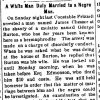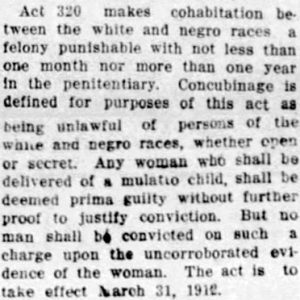calsfoundation@cals.org
Anti-miscegenation Laws
Anti-miscegenation laws were edicts that made it unlawful for African Americans and white people to marry or engage each other in intimate relationships. The measures first appeared in the United States in colonial times and had two functions. First, the laws helped maintain the racial caste system necessary for the expansion of slavery and the idea of white supremacy. If white masters took slave women as lovers and fathered children by them, anti-miscegenation laws ensured that the children remained slaves because the illicit nature of the relationships left biracial children with none of their father’s free status. Second, anti-miscegenation statutes gave white men greater power to control the sexual choices of white women. In the colonial period, white patriarchs used the laws to discourage white women from choosing African Americans as husbands and paramours.
In October 1837, the Arkansas legislature enacted the state’s first anti-miscegenation law. The statute declared all marriages between white people and Negroes or mulattos “illegal and void.” Relative to anti-miscegenation edicts in other Southern states, the Arkansas law was mild. The measure had no punishment provision, nor did it specifically define “Negro or mulatto.” The tepid nature of Arkansas’s first anti-miscegenation law probably stemmed from the fact that Arkansas had fewer than 500 free African Americans when the law was enacted. Because other Arkansas laws denied slaves the right to marry, legislators probably deemed it unnecessary to establish a more stringent law.
Immediately after the Civil War, state leaders worked to adjust some of the laws to accommodate emancipation, including new provisions legitimizing the marriages of former slaves. But the changes had no effect on the state’s anti-miscegenation law. In the Acts of Arkansas of 1866, a clause declared that none of the new edicts authorizing African Americans to marry meant that anyone had the right to do so across the color line.
The onset of Radical Reconstruction in March 1867 meant further changes would come to the state’s laws. At the new constitutional convention required by the federal Reconstruction acts, black delegates led by William Grey of Phillips County, along with their white Republican allies, defeated a proposed amendment to the state constitution that would have prohibited marriage between black and white citizens. The failure of the delegates to attach an anti-marriage clause to the new state constitution signaled that the effort to prevent interracial marriage would have little support in a Republican-controlled state. In fact, after the convention, the legislature never discussed enacting a new anti-miscegenation law, and the state omitted the statute from the revised civil code in 1874. Many Arkansas interracial couples married with impunity throughout the Radical Reconstruction period.
The Democratic Party reemerged in 1874 as the dominant political organization in Arkansas. But, to discourage federal interference in the state, Democratic leaders established “fusion” governments at the county level that allowed white and black Republicans to retain some local power. Although the anti-miscegenation law reappeared in the civil code of 1876, enforcement was sporadic at best. Well into the 1880s, many interracial couples lived together as husband and wife with little state interference.
As in other Southern states, racial attitudes became less tolerant in the 1890s. The emergence of the Populist Party with its appeal to poor people motivated Democrats to work to disenfranchise African Americans. Simultaneously with the effort to repress African Americans, state authorities tightened their enforcement of anti-miscegenation edicts. Increasingly, interracial couples found themselves in courtrooms, fighting to sustain their relationships. At least one of the interracial couples that married in 1874, Thomas and Mary Dodson, had their nuptials declared invalid in Dodson v. State (1894).
In 1911, the legislature, led by M. B. Kersh of Lincoln County, passed a measure banning interracial cohabitation. The law made such an offense a felony punishable by one month to a year in prison. In theory, the act gave authorities more power to prohibit and punish interracial coupling. But there is no evidence that it made much difference in helping the state prevent sex across the color line.
The post–World War II era found Arkansas laboring to reassert its commitment to maintaining Jim Crow laws—those designed to keep African Americans in subjugation. In 1947, concerned about the growing militancy of African Americans and their demands for civil equality, state legislators enacted a slate of provisions that further segregated black and white people. Included was a revised anti-miscegenation law that prescribed specific penalties for people convicted of having interracial relationships. The penalty for a first conviction was a fine of $20 to $100. Second convictions subjected individuals to a $100 fine and up to a year in prison. Third and subsequent convictions would result in one to three years in prison.
Anti-miscegenation laws remained part of the state civil code until 1968. However, in the twentieth century before their eradication, the state appeared to have been frustrated in its limited attempts to enforce the laws. In fact, in the three cases that made it to the state Supreme Court on appeal in the twentieth century, the state lost each case on the grounds that it had not satisfactorily proven that a relationship had existed between the accused people. After the U.S. Supreme Court rejected the rights of states to ban interracial marriage in Loving v. Virginia (1967), the legislature quickly moved to bring the state’s laws into compliance with the high court’s ruling.
For additional information:
Palmer, Paul C. “Miscegenation as an Issue at the Arkansas Constitutional Convention of 1868.” Arkansas Historical Quarterly 24 (Summer 1965): 99–119.
Robinson, Charles F. Dangerous Liaisons: Sex and Love in the Segregated South. Fayetteville: University of Arkansas Press, 2003.
———. Forsaking All Others: A true Story of Interracial Sex and Revenge in the 1880s South. Knoxville: University of Tennessee Press, 2010.
———. “‘Most Shamefully Common’: Arkansas and Miscegenation.” Arkansas Historical Quarterly 60 (Autumn 2001): 265–83.
Charles F. Robinson II
University of Arkansas, Fayetteville
 Chesser and Holly Marriage Case of 1888
Chesser and Holly Marriage Case of 1888 Civil Rights and Social Change
Civil Rights and Social Change Civil War through Reconstruction, 1861 through 1874
Civil War through Reconstruction, 1861 through 1874 Law
Law Malpass, Charles (Lynching of)
Malpass, Charles (Lynching of) Act 320
Act 320 



Comments
No comments on this entry yet.